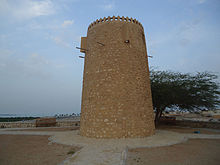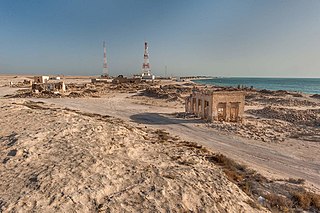List of heritage areas
| Heritage Area number | Name | Image | Agency | Type of Monument | Location/Coordinates | Date Established | Description | Opening Timings |
| HAR10278 | Al Zubarah Archaeological Site [7] |  | Qatar Museums | Archeological Monument | (N25° 58.623 E51° 1.727) QNG (181264 – 469096) | 1760 | Is a ruined and ancient fort located on the north western coast of the Qatar peninsula in the Al Shamal municipality, about 105 km from the Qatari capital of Doha. | 9am to 5pm |
| HAR10180 | Fraiha Archaeological Site [8] |  | Qatar Museums | Archeological Monument | GPS Coordinates (N26° 0.909 E51° 2.500) QNG (182559 – 473316) | 18th to the mid-19th century | Prior to visit, please contact Qatar Museums | |
| HAR10306 | Al Ruwaida Archaeological Site [9] |  | Qatar Museums | Archeological Monument | GPS Coordinates (N 26° 5.016 E 51° 8.832) QNG (193128 – 480889) | end of the 18th century | Is a ruined town in northern Qatar. | Prior to visit, please contact Qatar Museums |
| HAR20829 | Murwab Archaeological Site | Qatar Museums | Archeological Monument | GPS Coordinates (N25° 51.548 E51° 01.270) QNG (180482 – 456034) | 1985 | is an archaeological site in northwest Qatar. | Prior to visit, please contact Qatar Museums | |
| HAR1891 | Barzan Towers |  | Qatar Museums | ARCHITECTURAL HERITAGE | GPS Coordinates (N25° 25.073 E51° 24.798) QNG (219860 – 407152) | 1910 and 1916 | ||
| HAR4161 | Al Khor Towers Eastern Tower |  | Qatar Museums | ARCHITECTURAL HERITAGE | GPS Coordinates 1-(N25° 41.303 E 51° 30.371) QNG (229139 – 437135) | 20th Century | ||
| HAR668 | Al Khor Towers Southern Tower | Qatar Museums | ARCHITECTURAL HERITAGE | (N25° 41.281 E 51° 30.264) QNG (228960 – 437094) | 20th Century | |||
| HAR669 | Al Khor Towers Western Tower |  | Qatar Museums | ARCHITECTURAL HERITAGE | (N25° 41.348 E51° 30.049) QNG (228603 – 437211) | 20th Century | ||
| HAR3552 | Ain Hleetan Well | Qatar Museums | ARCHITECTURAL HERITAGE | GPS Coordinates (N25° 41.358 E51° 30.069) QNG (228635 – 437230) | 20th Century | |||
| HAR3546 | Old Palace | Qatar Museums | ARCHITECTURAL HERITAGE | GPS Coordinates (N25° 17.276 E51° 32.899) QNG (233479 – 392783) | 20th Century | |||
| HAR1662 | Al Rekayat Fort | Qatar Museums | ARCHITECTURAL HERITAGE | Access: 2 km off-road GPS Coordinates (N26° 03.075 E51° 07.825) QNG (191444 – 477303) | ||||
| HAR10143 | Al Thaghab Fort | Qatar Museums | ARCHITECTURAL HERITAGE | Access: 3.5 km off-road GPS Coordinates (N26° 1.962 E51° 7.028) QNG (190115 – 475252) | ||||
| HAR10061 | Al Jumail Heritage Village | Qatar Museums | ARCHITECTURAL HERITAGE | Access: 0.5 km off-road GPS Coordinates (N26° 5.699 E51° 9.292) QNG (193895 – 482150) | ||||
| HAR294 | Al Jassasiya East Rock Art Site |  | Qatar Museums | CULTURAL AND NATURAL HERITAGE | GPS Coordinates (N25° 57.208 E51° 24.395) QNG (219099 – 466484) | Prior to visit, please contact Qatar Museums | ||
| HAR351 | Al Jassasiya West Rock Art Site |  | ||||||
| HAR2023 | Jazirat Bin Ghannam Archaeological and Natural Heritage Site | Qatar Museums | CULTURAL AND NATURAL HERITAGE | GPS Coordinates (N 25° 41.553 E 51° 32.990) QNG (233519 – 437607) | ||||
| HAR689 | Zekreet Fort | Qatar Museums | CULTURAL AND NATURAL HERITAGE | GPS Coordinates (N25° 29.405 E50° 50.676) QNG (162665 – 415190) |







